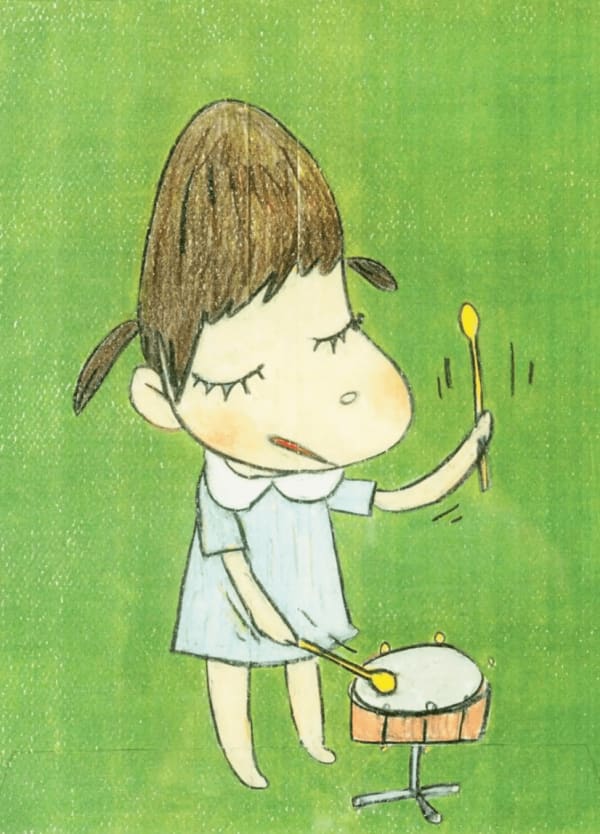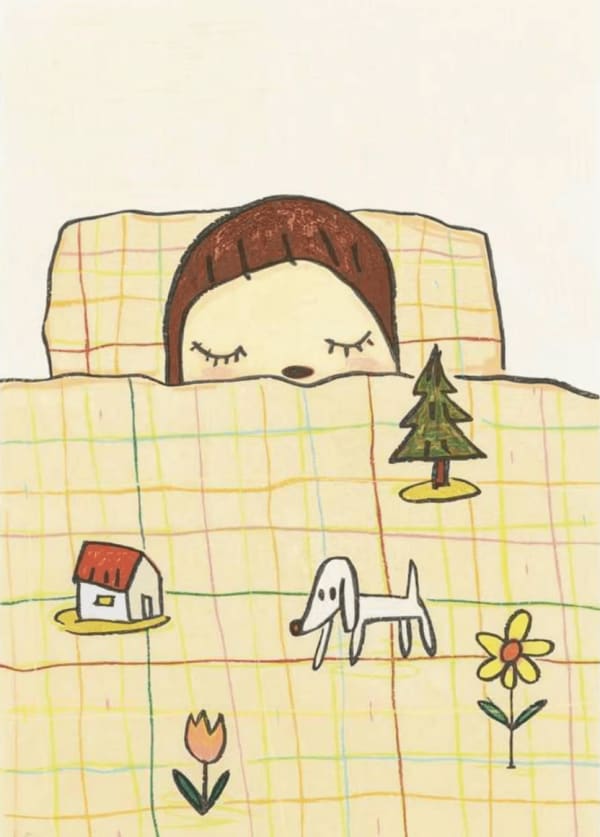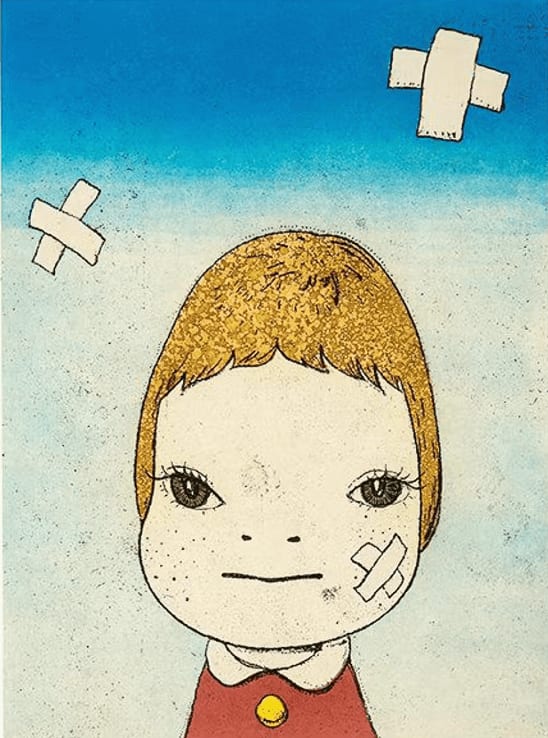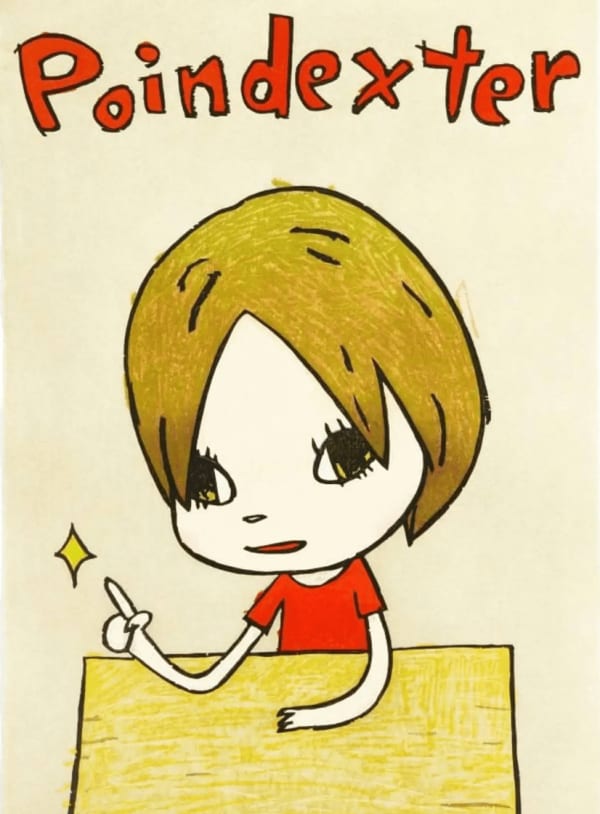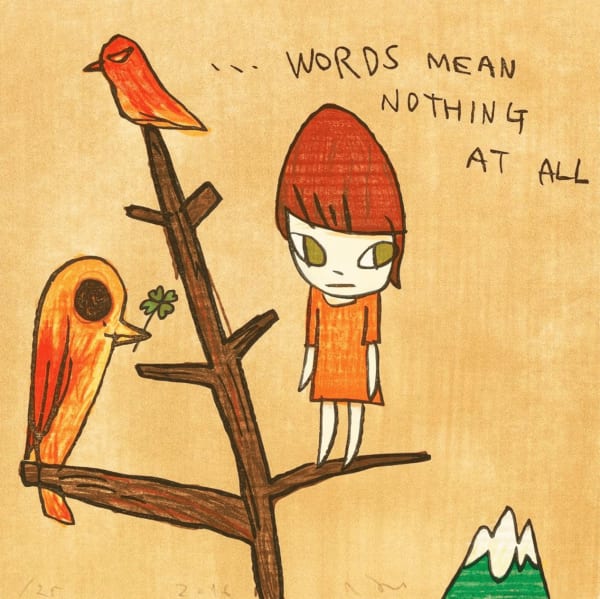Yoshitomo Nara’s work is instantly recognizable, filled with his signature characters—wide-eyed, defiant, and often carrying an air of mischief or quiet rebellion. His paintings and drawings frequently feature young children with exaggerated heads, sharp gazes, and subtly expressive faces that shift between innocence and menace. These characters, often alone in vast, empty backgrounds, exude a powerful emotional intensity that belies their apparent simplicity. Whether wielding tiny knives, standing with arms crossed, or simply staring with an unsettling directness, Nara’s figures challenge the viewer’s expectations of childhood and vulnerability. His work is deeply psychological, drawing upon themes of loneliness, alienation, and the complexities of youthful emotion.
One of Nara’s most essential motifs is the duality of innocence and danger. His characters often appear childlike yet possess an uncanny depth, their expressions hinting at hidden emotions—defiance, sadness, or even aggression. The frequent inclusion of small weapons, from knives to matches, underscores this tension. Yet, rather than feeling overtly violent, these elements serve to symbolize empowerment, resistance, and a quiet refusal to conform. His figures are not passive; they are self-possessed, challenging the viewer with their knowing stares. In some cases, they evoke a punk rock sensibility—rebellious but not without vulnerability.
Nara’s influences are varied, reflecting both his personal history and broader cultural currents. Growing up in post-war Japan, he was deeply influenced by the aesthetics of manga and anime, particularly the work of Osamu Tezuka. The large, expressive eyes of his characters owe much to this tradition. At the same time, Western pop culture played a crucial role in shaping his artistic sensibilities. As a young artist, he was drawn to the music and ethos of punk rock, which continues to inform the defiant attitude of his figures. The raw, emotive power of punk music, with its themes of discontent and individualism, echoes in his work’s emotional immediacy.
During his time studying in Germany at the Kunstakademie Düsseldorf in the 1980s and ‘90s, Nara absorbed the influences of German Neo-Expressionism and artists like Anselm Kiefer and Sigmar Polke. This period was critical in his development, pushing him toward a looser, more spontaneous painting style. His early works were more textural and expressive, often darker in tone. However, as he refined his approach, his figures became more distilled, their forms simplified but their emotional resonance deepened. His exposure to Western contemporary art, particularly in Europe, helped him blend Japanese aesthetics with a global visual language.
Over time, Nara’s artistic style has evolved, moving away from overtly textured surfaces toward smoother, more controlled compositions. The backgrounds of his paintings became more minimalistic, allowing his characters to take center stage with even greater psychological weight. Despite this refinement, the emotional intensity of his figures has only grown more profound. His later works often depict his characters in moments of quiet introspection, their rebelliousness tempered by a sense of melancholy or solitude. This evolution reflects his own shifting perspective on childhood and identity, no longer solely fixated on defiance but also on the fragility and complexity of human emotion.
Another key motif in Nara’s work is the depiction of isolation. His figures are almost always alone, placed in undefined spaces that heighten their sense of detachment. This reflects Nara’s own experiences of loneliness, particularly during his childhood in rural Japan and later during his time abroad. Yet, rather than presenting isolation as purely negative, his work suggests that solitude can be a source of strength and self-discovery. His characters are self-contained, independent, and unafraid to exist on their own terms. This emphasis on individual emotion and psychological depth is a hallmark of his art.
Nara’s sculptures and installations also expand on his core themes. His three-dimensional works often present his characters in more immersive ways, allowing viewers to engage with them from different perspectives. His installations, which sometimes feature small huts or house-like structures, invite viewers into intimate, almost secret spaces. These works reinforce the themes of introspection and inner worlds, drawing audiences deeper into the psychological landscape of his figures. By creating environments that feel simultaneously inviting and isolating, he challenges viewers to reflect on their own emotions and experiences of solitude.
Ultimately, Yoshitomo Nara’s work is a deeply personal exploration of childhood, memory, and emotion. His ability to capture the nuances of youthful rebellion and vulnerability has resonated with audiences worldwide, making his art both visually compelling and emotionally profound. Through his unique blend of Japanese aesthetics, Western influences, and deeply felt personal experiences, Nara has crafted a body of work that continues to evolve while remaining unmistakably his own. His characters, with their piercing gazes and quiet defiance, stand as testaments to the complexity of human emotion—simultaneously tender and fierce, isolated yet intensely present.
For more information on our Yoshitomo prints for sale and to buy Yoshitomo art, please contact info@guyhepner.com for our latest availabillities.





